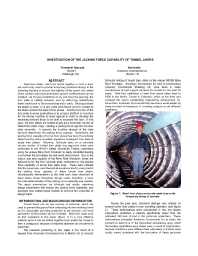Mining Publication: Investigation of the Jacking Force Capability of Tunnel Liners
Original creation date: February 2002
Steel liner plates, which are bolted together to form a shell, are commonly used to provide temporary protective linings in the tunneling industry to ensure the stability of the tunnel and safety of the workers until more permanent ground reinforcement can be installed. As the ground deforms to try and close the opening, the liner plate is radially stressed, and by deforming redistributes these loads back to the surrounding insitu earth. Grouting behind the plates is done to fill any voids and ensure uniform contact to the strata around the back of the plates. Another function of the liner plate in some applications is to act as a platform or structure for the mining machine to react against in order to develop the necessary forward thrust to be able to excavate the face. In this case, the liner plates are loaded axially as a horizontal column of bolted liner plate rings, creating a jacking force against the liner plate assembly. In general, the buckling strength of the plate sections determines the jacking force capacity. Historically, the jacking force capacity of tunnel liner plates has been theoretically determined by some simplistic equations developed from tests of single liner plates. Recently, full-scale tests on a complete circular section of bolted liner plate ring segments have been conducted in the NIOSH Safety Structures Testing Laboratory using the unique Mine Roof Simulator to apply controlled loading in a manner that simulates the real world environment. Due to the unique size and capacity of the Mine Roof Simulator, these are believed to be the first full-scale tests conducted on the jacking force capability of tunnel liner plate rings. These tests indicate that the previously used theoretical equations tend to over predict the jacking force capacity of these tunnel liner plates. Unanticipated deformations in the field have been observed at loads below these theoretical design loads, therefore, a more accurate determination of the jacking force capability was needed. This report summarizes the full-scale test results, examines design parameters that impact the jacking force capability, and develops new mathematical models to improve the prediction of design loads.
Authors: TM Barczak, R Smith
Conference Paper - February 2002
NIOSHTIC2 Number: 20023187
2002 SME Annual Meeting, Feb 25-27, Phoenix, Arizona, preprint 02-186. Littleton, CO: Society for Mining, Metallurgy, and Exploration, Inc., 2002 Feb; :1-13
See Also
- Above-the-Earth Field Contours for a Dipole Buried in a Homogeneous Half-Space
- Degasification System Selection for U.S. Longwall Mines Using an Expert Classification System
- Determination of In Situ Deformation Modulus for Cemented Rockfill
- Effects of Weak Bands on Pillar Stability in Stone Mines: Field Observations and Numerical Model Assessment
- Elastic and Shear Moduli of Coal Measure Rocks Derived from Basic Well Logs Using Fractal Statistics and Radial Basis Functions
- Modeling Natural Gas Explosions for Coal Mine Safety
- Pillar Strength and Design Methodology for Stone Mines
- Propagation of UHF Radio Waves in Limestone Room and Pillar Mines
- Stochastic Modeling of Gob Gas Venthole Production Performances in Active and Completed Longwall Panels of Coal Mines
- Straight Line Walking and Path-Turn Identifying Algorithms for a Tracking Device Used in Underground Mines
- Page last reviewed: 9/21/2012
- Page last updated: 9/21/2012
- Content source: National Institute for Occupational Safety and Health, Mining Program


 ShareCompartir
ShareCompartir
